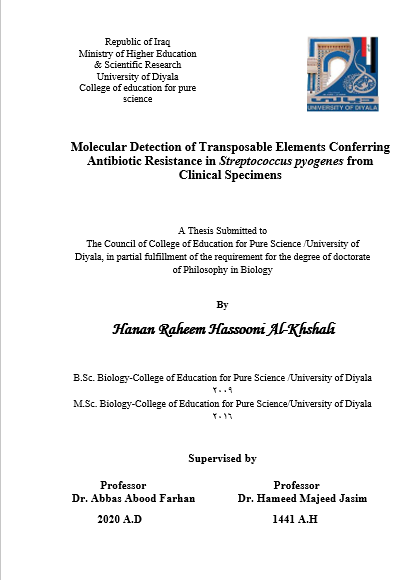Summary
A total of 500 clinical Specimens collected from patients suffering from pharyngitis, tonsillitis, and otitis attended consulting clinic at Baqubah teaching hospital, Al-Batoul teaching hospital and private clinics in Diyala governorate, the consulting clinic at central child teaching hospital and Baghdad teaching hospital in Baghdad governorate, private clinics in Erbil governorate, and Beirut medical center / American university in Lebanon. From these clinical samples, a total of 93 bacterial isolates were obtained after culturing on (blood agar medium and β- selective Streptococcus agar medium) supplemented with 5% fresh human blood. Among these isolates only 22 were identified as S.pyogenes according to their morphological, cultural, and biochemical characteristics. Furthermore, the identification of these isolates was confirmed by using Vitek-2 system and molecular identification according to the results of amplification and sequencing of 16S rDNA gene.
Molecular serotyping of S.pyogenes isolates showed that these isolates were belong to group A streptococcus according to the nucleotide sequence of emm gene in each isolate and the guidelines stated by the centers for disease control and prevention (CDC). Moreover, results showed that S.pyogenes isolates were belong to seven serotypes (emm104.1, emm 28, emm 44, emm 63, emm 1, emm 5.103 and emm 90) for the emm patterns E2, E3, E4, E6, A-C3 and M5, respectively.
Susceptibility of S.pyogenes isolates to different antibiotics was examined, results showed that the isolates were variable in their susceptibility as the most (90.9%) were resistant to erythromycin, then to minocycline (68.1%), lincomycin (59%), tetracycline (54.5%), clindamycin (50%), azithromycin (36.3%), clarithromycin (36.3%), doxycycline (31.8%) and oxytetracycline (27.2%).
Transposable elements conferring antibiotic resistance in S.pyogenes isolates were detected first by extraction of genomic DNA by using extraction kit (Biotechnology/Korea), then amplification each transposon by using specific primers. The results of amplification by using PCR technique under the optimum conditions showed that there are three of the isolates harboring Tn3872, two isolates harboring Tn6002, 14 isolates harboring Tn1545, and 1 isolate harboring Tn6003. These transposons (Tn3872, Tn1545, Tn6002, and Tn6003) are a composite transposons conferring both erythromycin and tetracycline resistance. The results also showed that there was one isolate harboring a variant of mobile prophage-associated genetic elements Фm46.1 carrying erythromycin and tetracycline resistance genes. Furthermore, it was also found that 13 isolates harboring Tn554, five isolates harboring Tn917, these two transposons conferring erythromycin resistance. The results also showed that there are eight isolates harboring Tn916; two isolates harboring Tn5397 and other two isolates harboring Tn5252. These transposons (Tn916, Tn5397, and Tn5252) conferring tetracycline resistance.
Nucleotide sequence for each transposon under study was sequenced and compared with their counterpart sequences for transposable elements located in standard strains of S.pyogenes recorded in NCBI database. The results showed that there is 100% identity between the amplified sequences of each transposable element with those indicated in NCBI under the accession number mentioned for these transposons.





